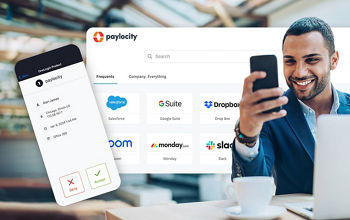resources
How to Improve Employee Connections in the Workplace
August 31, 2023
Improve employee connection by using HR tech that connects employees to each other, the organization, and their purpose.
Blog Post

Clock in. Clock out. Stay connected?
Employees’ expectations have changed a lot in the last few years. There’s an increasing push to make work more than just, well, work — and staff often want their employers to take the lead. But 43% say their organizations are falling short in helping them feel connected to coworkers.
Beyond simple goodwill, there’s a convincing business case to support taking this problem seriously.
Research shows time and time again that connected employees make fewer mistakes, contribute higher quality work, are more satisfied, and are much more likely to stay at their organization for many years.
And although employee connection and engagement is on the rise, these results don’t happen overnight and without intention. Strong workplace connections must be built and actively nurtured, with effort from both workers and the organizations that employ them.
Let’s explore the key components of a connected workplace and five actionable strategies for improving employee connections within your organization.
Key Takeaways
- Connected employees make fewer mistakes, contribute higher quality work, are more satisfied, and are much more likely to stay at their organization for many years.
- Employee connection comes from three avenues: connection to each other, to the organization, and to individual purpose.
- There are many strategies to help build employee connections, but transparency, employee empowerment, communication, celebration, and genuine relationships lie at the heart of a well-connected organization.
What Is a Connected Workplace?
Connection is the glue that holds organizations together and the engine that propels them forward. But it doesn’t only refer to colleagues’ relationships.
Workplace connection is threefold for employees:
- Connection to each other
- Connection to the organization (including the mission, vision, and values)
- Connection to their own individual purpose.
Because a truly connected workplace is multidimensional, you need the right HR tools to facilitate conversations, camaraderie, and collaboration. It needs to be easy for employees to find common ground with each other, HR, and leaders in the organization.
But, in a practical sense, a connected workplace is also the culmination of streamlined workflows, collaboration tools, open lines of communication, and unified systems.
Without modern HR technology, a truly connected organization is out of reach — especially in the era of remote and hybrid work.
When organizations create a connected employee experience, they see improved productivity, retention, engagement, satisfaction, and loyalty. And these metrics are the building blocks of larger organizational outcomes, such as profitability.
Why Are Strong Employee Connections Important?
Workplace connection plays an important role in employee well-being and retention. Disconnected employees report higher anxiety, depression, burnout, and stress. They're also three times more likely to quit.
Therefore, attracting, engaging, and retaining employees depends on employee connectedness. In fact, 77% of employees say their relationships with their colleagues are a key indicator of job satisfaction.
If your organization is lacking, the costs can be astronomical.
Every time an employee leaves, an organization can find itself in a battle against declining morale, lost customers, or even negative perceptions of leadership or the organization.
And the literal price? It’s estimated that losing an employee costs the company 1.5-2x that employee’s salary.
Connection extends to operations as well, going hand-in-hand with communication and collaboration. Without all three, your business is less productive and runs less smoothly.
How to Improve Employee Connections
The Great Resignation and “quiet quitting” movements have shown employers that their workforces are, in fact, willing to leave. Forty percent of employees surveyed in 2022 said it’s at least somewhat likely they will leave their jobs in the next 3-6 months. So, organizations need to pivot from quick fixes like bonuses or free coffee to what employees need more than anything: connection.
The takeaway? Employers need to pivot from quick fixes like free coffee and pinball to what employees need more than anything: connection.
Here are six proven strategies for building strong employee connections.
1. Encourage and Embed Peer Recognition
More than 60% of employees in the U.S. are lonely, according to a 2020 Cigna study, and lonely employees are less productive, costing organizations an average of $4,200 per year in lost workdays.
While connections to HR, leadership, and the organization are vital, employees need to connect with each other to stay motivated.
How can you do this? Well, start with regularly celebrating personal and professional wins. Encourage employees to call out successes in real-time and keep these acknowledgments as a record of their greatest achievements.
You could also invest in dedicated peer recognition tools, which enable your employees to easily give and receive appreciation in a social media-like format. This builds a sense of belonging, fuels connection, and may even boost productivity
Learn More: 16 Employee Appreciation Ideas to Show Gratitude
2. Decrease the Digital Divide in Remote and Hybrid Workplaces
Many workers want remote and hybrid work environments. And 76% of employees say a shift to hybrid work environments improved their organization’s culture.
But without the daily social events like water cooler chats, break room conversations, and spur-of-the-moment happy hour outings, connection can dwindle or even disappear.
Organizations with hybrid or remote workspaces need to be intentional and creative about providing opportunities for connection, and HR technology that offers connection-building capabilities can help.
Use HR tech to create immersive, high-touch experiences to engage remote employees. Your Human Capital Management (HCM) solution should be able to convey warmth, excitement, and depth of connection across your organization, whether employees are onsite or working from home.
Here are some examples of how you can leverage HR tech to build connection in any type of workplace:
- Start with personalized welcome videos during onboarding.
- Create digital discussion groups centered around teams for easy communication between supervisors and teammates.
- Continue building connection through employee community groups centered on interests, like fitness fans or avid bakers.
These tactics don’t need to be limited to hybrid environments either. These same engagement strategies can apply to deskless employees who spend most of their time in the field, or to connect employees who may not work the same shift or season.
The intent is the same: create connections in the workplace for employees who may not often share the same physical space.
3. Create Space for Socialization
If you're looking to build better employee connections and create a stronger team atmosphere, socialization is key.
It is no secret that social events and interactions such as team-building activities, group meals, escape rooms, and even casual conversations at the water cooler can have a significant impact on how your team works together.
Social events provide employees with the opportunity to connect and form meaningful relationships. Having a close friend in the workplace can be a real morale booster, leading to increased engagement and satisfaction in the job.
Believe it or not, your HCM solution can be a valuable asset for facilitating these social moments.
Use social collaboration tools to spread the word about your virtual Halloween costume party. Get everyone involved with surveys and polls to source activity ideas. And share those post-event photos! They're great for bonding and keeping the memories alive.
4. Give Employees a Voice
Employees are more likely to feel connected to their organizations when it’s clear their input is not only welcomed but also valued.
Employee surveys provide an avenue for individuals to speak up and be heard. They can serve a wide range of purposes, from gathering ideas for the upcoming team lunch to an automated 90-day check-in with a new hire. Be intentional about proactively and regularly reaching out to your employees to solicit feedback.
And once you’ve gathered the feedback, be sure to act on it where you can so your employees feel like their voice matters.
What’s more, regularly leveraging surveys enables your organization to gather insights about systemic issues with employee engagement, identify winning retention strategies, encourage bright new ideas, and more. You can find out why employees stay, what they need to feel more satisfied, and how to improve the company culture — all you have to do is ask.
5. Centralize and Open Lines of Communication
Employees want intuitive and accessible communication channels that work for them. Think mobile capabilities, video, and social media-esque communication hubs that they don’t have to learn because it’s already familiar.
Communication should work on their schedule and wherever they go, so utilize channels they can check while waiting in line for their latte or after pulling into the parking lot to pick their kids up from school.
Invest in communication platforms that integrate essential communication — organization updates, file sharing, and messages from the CEO — and opportunities to connect on a human-to-human level. Communication should also be bi-directional, so everybody can participate.
Paylocity’s Community is a communication network that offers chat features, file sharing, and a company-wide feed. Not only does it connect people to each other, but it also connects people to the organization with all mission-critical information in one place.
Ask the Expert groups, which you can customize based on subject matter, eliminate tedious email chains and allow employees to go straight to the source. Plus, in-house experts can showcase their skills in these groups and provide learning and development support to their peers, which fosters connection.
6. Leverage the Power of Leadership
One of the best ways to improve connection at your organization is to have your leaders champion connection from the top down.
Paylocity’s Data Science team examined usage data from Community to measure the impact of leadership on employee engagement. The results were conclusive.
Executives who engaged with employees on Paylocity’s Community platform through video posts, comments, emojis, and more saw:
- 15-25% lower voluntary turnover
- 24% higher headcount
- 70% more return on investment with their HCM tools
When leadership activates connection across the organization, employees follow suit, and the benefits for the organization are substantial.
Improving Connection with HR Technology
There are a variety of strategies for improving connection in the workplace, and HR tech can be an essential partner for executing these tactics.
Paylocity’s all-in-one HR and payroll solution includes a comprehensive suite of employee experience tools, all designed to strengthen the connections between your organization and employees.
Learn more about how Paylocity can help HR pros foster the connections that employees need to stay engaged, satisfied, productive, and loyal to your organization.

Reach Your Workforce Wherever They Are
We all want to get more done with less email and fewer meetings – yet reaching a workforce, whether they're remote, on-site, or hybrid, can be tricky. Improve communication, enable engagement, and connect all your employees with Community. This modern social collaboration tool allows your workforce to access newsletters, policies, and emergency updates, while also giving a central hub for your employees to come together.



